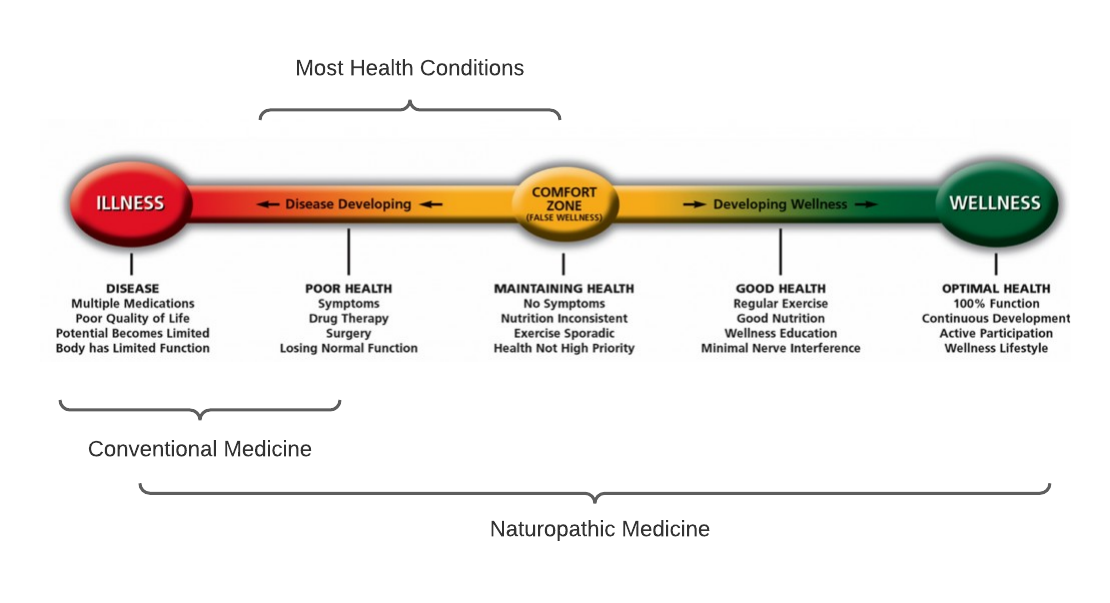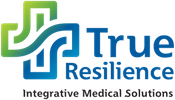Functional Medicine Chandler, AZ
Running through conventional medical testing without finding answers can be frustrating. Part of the reason for this is that modern medical testing is aimed at finding the most serious and life-threatening conditions. Therefore modern medicine is absolutely fantastic at using heroic measures to keep people from dying in acute situations. This doesn’t necessarily mean that it can also help identify less than life-threatening problems with the goal of helping people reach or maintain optimal health. For example, an MRI of the brain of a patient with headaches can tell us if the patient has a brain tumor, but if anything else is causing the headache it will not be of any use in the diagnosis.
Another way of communicating this idea is through the following graphic. With optimal health being on the right and severe illness being on the left, health is a spectrum. In our experience, lot of people who have health concerns are outside of the reach of conventional medicine. This isn’t a bad thing, because it doesn’t mean that they can’t get better, it just means that medicine doesn’t have anything for them yet. The patient who has symptoms is still can’t rejoice after being told they are fine or that they have a clean bill of health from their doctor because the tests aren’t calibrated to find their type of problem. Or the wrong type of problem is being looked for.
When people are a the point where their illness is showing up on conventional tests and imaging, they are already at 15% to 20% of optimal function. It also usually means that multiple systems are dysfunctional because the body is excellent at healing itself and can draw resources from strong areas to fortify weaker ones.

The Limitations of Bloodwork
Bloodwork is a snapshot in time. Consider watching a 24 hour video of the kitchen of a busy household. We know that many of the body’s hormones cycle up and down over the course of one day, ie cortisol. A lot of the time nothing will be going on, but come [6:00] AM the kids are running around playing while their parents are busily preparing food, signing off on their homework, coordinating plans for the weekend, etc. Then once everyone is off to school and work there is peace again (albeit plus the fallout from breakfast ie dishes piled up in sink and applesauce splattered all over the walls). Now imagine a taking a picture at one time of day of that kitchen. It can be hard to imagine
While it isnt a perfect analogy for the biochemical processes in the body, it does get across the idea that a snapshot in time doesn’t tell the whole story. Even though the body does keep blood levels of different biomolecues in fairly tight ranges, blood chemistry still changes second to second, all day every day, depending on people’s thoughts, their environment, what they eat, and how they move.
We only measure ~ 30 to 100 biomarkers. Contrast this will all of the hormones in the blood, metals, microbial antigens, Neuro-peptides, etc. This is to say, while we have discovered that there are some biomarkers that correlate with specific disease states, bloodwork is in no way to be relied upon as the only measure of overall health.
Beyond all of the above limitations, the ranges on bloodwork are misleading. The standard lab ranges that are given by the lab are based on population averages, not optimal values. This is problematic because the population of the US isn’t optimally healthy, especially the population who are getting bloodwork done the most (people who are sick are the ones that go to the doctor). Using these wide ranges limits the interventions that doctors offer in a way that promotes sick care aka condition care. Using the example of blood sugar dysregulation, insulin resistance, and diabetes is a great way to elucidate the concepts of the conventional care model, and allows us to introduce an alternative, naturopathic medical care.
The road to diabetes, a case for functional medicine
The road to diabetes starts with dysregulation of blood sugar. Both stress (manifest in the body as epinephrine and cortisol release) and eating sugar, elevated blood sugars. This elevation of blood sugar causes the pancreas to release insulin, which causes the cells of the body to express glucose transport molecules on their cell membranes. This allows the cells to pull the sugar out of the bloodstream, bringing sugar levels down. This is all fine and wonderful, unless there is enough stress, or high enough blood sugar levels cause the pancreas to secrete more insulin than is needed, which can cause the blood sugar to dip lower than optimal (manifest as people feeling irritable, nervous or shaky between meals). This is the first sign of blood sugar dysregulation. At this point on bloodwork would look normal, even optimal.
The next stage is insulin resistance, which means the cells lose their ability to respond to insulin. This means that sugar isn’t brought into cells and isn’t metabolized to produce energy. Instead, it continues to circulate, forming advanced glycosylation end products (AGEs) that are inflammatory, or the sugar is converted into triglycerides which are stored in the liver (contributing to fatty liver disease) At this phase, blood sugar levels will still be in the “normal” range, but other biomarkers will be changing that alert us to the fact that the body has elevated blood sugar levels. These include higher blood sugar, insulin levels, and Hg A1C (an example of an AGE). At this stage, from a conventional standpoint, the patient’s fasting blood sugar may be creeping up towards the upper limit of 100 that the lab ranges use. This is an interesting place on the road to diabetes because even if the blood sugar does get to 100 and trigger that bold, high reading on the bloodwork, in my experience, nothing is recommended to the patient, other than them being told to lose weight if they are overweight. A Hg A1C will be ordered to keep an eye on how blood sugar levels are being handled over time.
If insulin resistance continues, the pancreas eventually stops working as efficiently, and blood sugar levels rise even higher. And when the fasting blood glucose comes back at 126, a random glucose result of over 200 (with symptoms of hyperglycemia), or your Hg A1C is over 6.5%, the diagnosis of diabetes is given and metformin can be started, at a dose of 500mg once to twice per day. This is expected to lower HgA1C by 1 to two points.
If the patient doesn’t change anything and the metformin fails to lower the HgA1C and it keeps going up (over 9), we jump to the injections which are aimed at increasing insulin in a last-ditch effort to get the cells to take up the excess blood sugar; either a GLP-1 receptor agonist (which stimulates the pancreas to secrete insulin and slows gastric emptying time, among a few other things), or straight up insulin. This does nothing to address the cause of the issue and only delays the inevitable decline towards retinopathy, neuropathy, gastroparesis, nephropathy (kidney disease), heart disease, and amputations, etc.
The Functional Approach
Contrast this with a functional, foundational, naturopathic approach
In the functional world, we would catch the very initial stages of blood sugar dysregulation through history and/or applied kinesiology, a form of biofeedback that we use in the office. At this point we have many interventions that we can make, including education about how blood sugar is managed by the body. Another thing we commonly do is counsel patients about the effects of stress on their body, including how stress affects their blood sugars. By helping people to attain better parasympathetic autonomic tone, we lower their cortisol levels, and by extension, improve their body’s blood sugar regulation. Improving autonomic tone can be done by adjusting the spine, doing craniosacral work, and by using low level laser therapy, PEMF therapy, and acupuncture. Working on the mental/emotional side of things is usually beneficial because we can put ourselves in a sympathetic, catabolic, inflamed state using nothing but our own doubtful, jealous, fearful, and self-pitying thoughts. Fasting and exercise to improve metabolic function can be helpful here, as can herbs and supplement protocols.
The next stage, insulin resistance, is something that becomes glaringly obvious when looking at bloodwork through a functional lens. Elevated fasting glucose, elevated hemoglobin A1C, elevated insulin, and changes in the lipid panel are all harbingers of the body’s loss of regulation of blood sugar. If we start to see this pattern emerging over time, we can be more aggressive in applying therapies to regain insulin sensitivity and lower blood sugar levels so that the situation doesnt get any worse. More aggressive methods to improve blood sugar regulation include ozone therapy (the closest thing that we have to exercise in a procedure), Exercise with oxygen therapy, and regenerative therapies like NAD+ IVs. By taking blood sugar seriously and making sure to address it before the pancreas starts shutting down, we are decreasing the liklihood of developing any chronic condition, and setting people up to live longer, healthier, and more vital and satisfying lives.
This example is quite a dramatic one, but so is having your foot amputated because you weren’t educated about the risks of not dealing with the pathology that your yearly bloodwork is screaming at you.
In Health,
Dr Evan
